Book contents
- Frontmatter
- Dedication
- Contents
- Preface
- Notation
- 1 Introduction
- 2 Stochastic Convergence
- 3 Delta Method
- 4 Moment Estimators
- 5 M–and Z-Estimators
- 6 Contiguity
- 7 Local Asymptotic Normality
- 8 Efficiency of Estimators
- 9 Limits of Experiments
- 10 Bayes Procedures
- 11 Projections
- 12 U -Statistics
- 13 Rank, Sign, and Permutation Statistics
- 14 Relative Efficiency of Tests
- 15 Efficiency of Tests
- 16 Likelihood Ratio Tests
- 17 Chi-Square Tests
- 18 Stochastic Convergence in Metric Spaces
- 19 Empirical Processes
- 20 Functional Delta Method
- 21 Quantiles and Order Statistics
- 22 L-Statistics
- 23 Bootstrap
- 24 Nonparametric Density Estimation
- 25 Semiparametric Models
- References
- Index
15 - Efficiency of Tests
Published online by Cambridge University Press: 05 June 2012
- Frontmatter
- Dedication
- Contents
- Preface
- Notation
- 1 Introduction
- 2 Stochastic Convergence
- 3 Delta Method
- 4 Moment Estimators
- 5 M–and Z-Estimators
- 6 Contiguity
- 7 Local Asymptotic Normality
- 8 Efficiency of Estimators
- 9 Limits of Experiments
- 10 Bayes Procedures
- 11 Projections
- 12 U -Statistics
- 13 Rank, Sign, and Permutation Statistics
- 14 Relative Efficiency of Tests
- 15 Efficiency of Tests
- 16 Likelihood Ratio Tests
- 17 Chi-Square Tests
- 18 Stochastic Convergence in Metric Spaces
- 19 Empirical Processes
- 20 Functional Delta Method
- 21 Quantiles and Order Statistics
- 22 L-Statistics
- 23 Bootstrap
- 24 Nonparametric Density Estimation
- 25 Semiparametric Models
- References
- Index
Summary
It is shown that, given converging experiments, every limiting power function is the power function of a test in the limit experiment. Thus, uniformly most powerful tests in the limit experiment give absolute upper bounds for the power of a sequence of tests. In normal experiments such uniformly most powerful tests exist for linear hypotheses of codimension one. The one-sample location problem and the two-sample problem are discussed in detail, and appropriately designed (signed) rank tests are shown to be asymptotically optimal.
Asymptotic Representation Theorem
A randomized test (or test function) in an experiment is a measurable map on the sample space. The interpretation is that if x is observed, then a null hypothesis is rejected with probabilityThe power function of a test is the function
This gives the probabilities that the null hypothesis is rejected. A test is of level ex for testing a null hypothesis Ho if its size sup does not exceed ex. The quality of a test can be judged from its power function, and classical testing theory is aimed at finding, among the tests of level ex, a test with high power at every alternative.
The asymptotic quality of a sequence of tests may be judged from the limit of the sequence of local power functions. If the tests are defined in experiments that converge to a limit experiment, then a pointwise limit of power functions is necessarily a power function in the limit experiment. This follows from the following theorem, which specializes the asymptotic representation theorem, Theorem 9.3, to the testing problem. Applied to the special case of the local experiments of a differentiable parametric model as considered in Chapter 7, which converge to the Gaussian experiment the theorem is the parallel for testing of Theorem 7.10.
Information
- Type
- Chapter
- Information
- Asymptotic Statistics , pp. 215 - 226Publisher: Cambridge University PressPrint publication year: 1998
